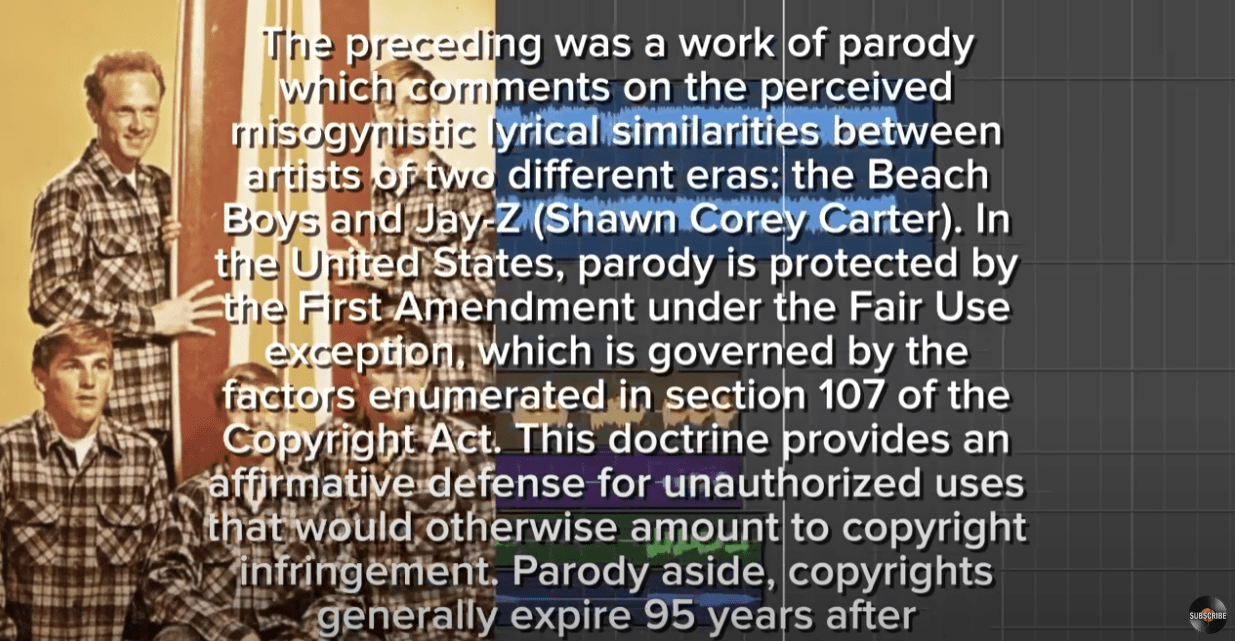In a world where copyright law has run amok, even creating a silly parody song now requires a massive legal disclaimer to avoid getting sued. That’s the absurd reality we live in, as highlighted by the brilliant musical parody project “There I Ruined It.”
Musician Dustin Ballard creates hilarious videos, some of which reimagine popular songs in the style of wildly different artists, like Simon & Garfunkel singing “Baby Got Back” or the Beach Boys covering Jay-Z’s “99 Problems.” He appears to create the music himself, including singing the vocals, but uses an AI tool to adjust the vocal styles to match the artist he’s trying to parody. The results are comedic gold. However, Ballard felt the need to plaster his latest video with paragraphs of dense legalese just to avoid frivolous copyright strikes.
When our intellectual property system is so broken that it stifles obvious works of parody and creative expression, something has gone very wrong. Comedy and commentary are core parts of free speech, but overzealous copyright law is allowing corporations to censor first and ask questions later. And that’s no laughing matter.
If you haven’t yet watched the video above (and I promise you, it is totally worth it to watch), the last 15 seconds involve this long scrolling copyright disclaimer. It is apparently targeted at the likely mythical YouTube employee who might read it in assessing whether or not the song is protected speech under fair use.
And here’s a transcript:
The preceding was a work of parody which comments on the perceived misogynistic lyrical similarities between artists of two different eras: the Beach Boys and Jay-Z (Shawn Corey Carter). In the United States, parody is protected by the First Amendment under the Fair Use exception, which is governed by the factors enumerated in section 107 of the Copyright Act. This doctrine provides an affirmative defense for unauthorized uses that would otherwise amount to copyright infringement. Parody aside, copyrights generally expire 95 years after publication, so if you are reading this in the 22nd century, please disregard.
Anyhoo, in the unlikely event that an actual YouTube employee sees this, I’d be happy to sit down over coffee and talk about parody law. In Campell v. Acuff-Rose Music Inc, for example, the U.S. Supreme Court allowed for 2 Live Crew to borrow from Roy Orbison’s “Pretty Woman” on grounds of parody. I would have loved to be a fly on the wall when the justices reviewed those filthy lyrics! All this to say, please spare me the trouble of attempting to dispute yet another frivolous copyright claim from my old pals at Universal Music Group, who continue to collect the majority of this channel’s revenue. You’re ruining parody for everyone.
In 2024, you shouldn’t need to have a law degree to post a humorous parody song.
But, that is the way of the world today. The combination of the DMCA’s “take this down or else” and YouTube’s willingness to cater to big entertainment companies with the way ContentID works allows bogus copyright claims to have a real impact in all sorts of awful ways.
We’ve said it before: copyright remains the one tool that allows for the censorship of content, but it’s supposed to only be applied to situations of actual infringement. But because Congress and the courts have decided that copyright is in some sort of weird First Amendment free zone, it allows for the removal of content before there is any adjudication of whether or not the content is actually infringing.
And that has been a real loss to culture. There’s a reason we have fair use. There’s a reason we allow people to create parodies. It’s because it adds to and improves our cultural heritage. The video above (assuming it’s still available) is an astoundingly wonderful cultural artifact. But it’s one that is greatly at risk due to abusive copyright claims.
Nope, it has been taken down by Universal Music Group
Let’s also take this one step further. Tennessee just recently passed a new law, the ELVIS Act (Ensuring Likeness Voice and Image Security Act). This law expands the already problematic space of publicity rights based on a nonsense moral panic about AI and deepfakes. Because there’s an irrational (and mostly silly) fear of people taking the voice and likeness of musicians, this law broadly outlaws that.
While the ELVIS Act has an exemption for works deemed to be “fair use,” as with the rest of the discussion above, copyright law today seems to (incorrectly, in my opinion) take a “guilty until proven innocent” approach to copyright and fair use. That is, everything is set up to assume it’s infringing unless you can convince a court that it’s fair use, and that leads to all sorts of censorship.
[…]
Source: When You Need To Post A Lengthy Legal Disclaimer With Your Parody Song, You Know Copyright Is Broken | Techdirt


